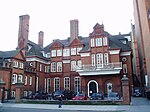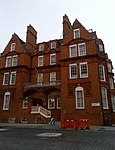Embassy of Afghanistan, London
Afghanistan government stubsAfghanistan–United Kingdom relationsDiplomatic missions in LondonDiplomatic missions of AfghanistanLondon building and structure stubs

The Embassy of Afghanistan in London (Pashto: د افغانستان اسلامي جمهوری سفارت; Dari: سفارت جمهوری اسلامی افغانستان) is the primary diplomatic mission of the Islamic Republic of Afghanistan to the United Kingdom. It is located at 31 Princes Gate in London's South Kensington district.The building now used for the embassy was constructed by Charles James Freake in the late 1850s.Earlier residents include the industrialist Charles Wright, chairman of Baldwins, and George Whiteley, 1st Baron Marchamley.Afghanistan bought this building in 1925.
Excerpt from the Wikipedia article Embassy of Afghanistan, London (License: CC BY-SA 3.0, Authors, Images).Embassy of Afghanistan, London
Princes Gate, London Knightsbridge
Geographical coordinates (GPS) Address Nearby Places Show on map
Geographical coordinates (GPS)
| Latitude | Longitude |
|---|---|
| N 51.5014 ° | E -0.1743 ° |
Address
Embassy of Afghanistan
Princes Gate 31
SW7 1QQ London, Knightsbridge
England, United Kingdom
Open on Google Maps









